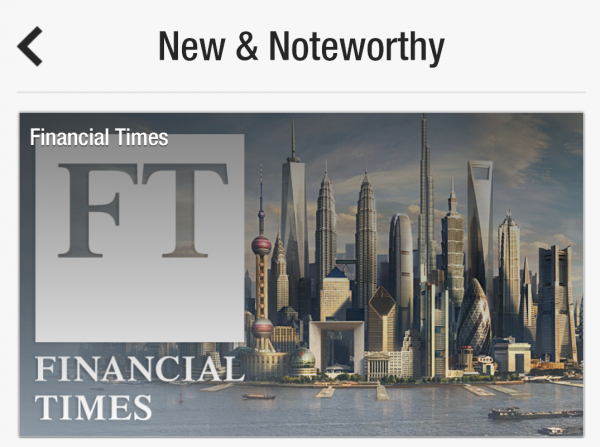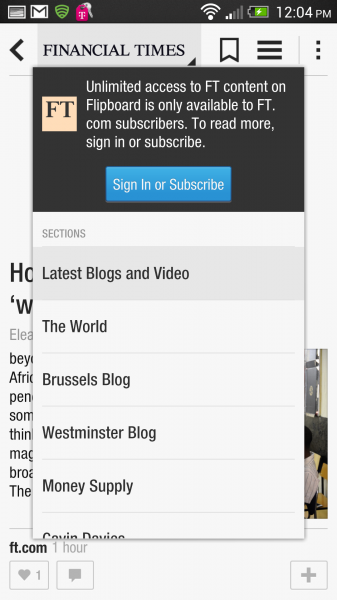Financial Times comes to Flipboard [Q&A]

May 9 was a big day for Flipboard. The personal news app launched a new version on Android, bringing feature parity with iOS, and the Financial Times debuted as a content provider. FT is unique among magazine news publications, by making people pay. Free rides are short lived; the newspaper lets registered users view a limited number of stories per month. More than that, requires a subscription.
Many people look at Flipboard as a pretty news aggregator -- a smorgasbord of valuable content served up for free; eat as much as you like. Financial Times brings the pay model with it. You still need a FT account. Registered users are limited to blogs and video, while subscribers get access to everything. I wonder if personal paper apps like Flipboard aren't the future news, with some -- even more -- content behind the paywall.
Charl Porter, group product manager, graciously took time to answer questions about the Financial Times' business model and how Flipboard fits into the overall strategy. Remember, FT is among the rare publications for which people pay.
BN: As a journalist, I am rather mortified by what the Google economy does to news. Free content supported by advertising, particularly when there is too much ad space to fill, isn't tenable. How is it Financial Times succeeds by making people pay?
CP: The FT's business is based on dual revenue streams (content and advertising), and more people than ever in our 125-year history are readers and subscribers of FT content.
We provide premium and essential news, commentary and analysis to an audience of over 600,000 paid subscribers (print and digital), who believe that FT content is worth paying for. Our successful channel-neutral strategy offers readers flexibility in how they choose to receive our content, and at its core is the metered access model we pioneered in 2007. Thanks to our digital access model, we now have deep knowledge of our audience and can apply data analytics for smarter marketing.
BN: Why Flipboard?
CP: We recognized early on that the continued success of our business depends on our ability to adapt to changing reader habits, and launching on a leading mobile app like Flipboard is a natural development for the Financial Times.
Mobile continues to drive growth and now accounts for a third of all FT.com page views, driving 15 percent of digital subscriptions.
Social media has changed the way people interact with brands, consume content and connect with each other. This is particularly true of the media industry and the way consumers discover and share news. At the FT, this deeper engagement with our audiences helps drive growth, and in 2012 the volume of visits to FT.com driven by social media grew by 35 percent.
 BN: Why Flipboard now -- and not sooner?
BN: Why Flipboard now -- and not sooner?
CP: We have been in discussions with Fliboard for a couple of years now to make sure that our proposition would work for both parties and across platforms, given we want to offer readers a multi-channel subscription with a single login. This launch has combined the FT’s award-winning journalism with a personalized reading experience on Flipboard. It also strengthens our presence on Android.
BN: How do you see apps like Flipboard, or even Google Currents, changing how people consume news?
CP: I see it as an opportunity for publishers like the FT to engage readers across multiple channels and devices. Our partnership with Flipboard allows reader to consume FT content in a new format using the same login as they would on FT.com or the FT web app. It’s a great way to get our brand out there without compromising our business model. We are still able to retain a direct relationship with our readers, which is key to our strategy.
BN: To be honest, I used to be a Financial Times subscriber but the Android tablet app just couldn’t satisfy. How would you compare the Flipboard experience?
CP: Flipboard provides an engaging leanback experience, and the app has successfully replicated the 'browsability' of a magazine. Our partnership with Flipboard does extend our presence on Android but we are working on enhancing the overall FT experience on Android. Our award-winning HTML5 FT web app now has more than 3.8 million users and was recently redesigned. The app is currently available on iOS now cleaner and easier to use, with more personalization and a choice of a static morning edition or a dynamically updating version.
BN: Flipboard lets users create custom magazines, of sorts. How does Financial Times sees this, and other mechanisms like it, fitting into broader editorial content and revenue-generating strategies?
CP: The social aspect of Flipboard’s custom magazines is exciting and we hope to play a part in that by allowing readers to use FT content within custom magazines while also experimenting with FT branded magazines.
We also have a dedicated iPad app for our award-winning How To Spend It magazine, which aesthetically matches its printed counterpart whilst offering the dynamism and immediacy of the web. The revenue on our HTSI platforms (tablet and desktop) more than doubled year on year.
